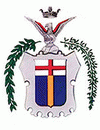Levanto (Lévanto or Levanto, locally Lievanto ) is a comune (municipality) in the province of La Spezia in the Italian region of Liguria, located almost 90 km southeast of Genoa and about 20 km northwest of La Spezia. The town is on the coast at the mouth of a river valley, between hills thickly wooded with olive and pine trees. The ridges on either side of the valley thrust out into the sea as the headlands of Mesco and Levanto. The municipality forms part of the coastal district known as the Comunità Montana della Riviera Spezzina, and part of its territory is included in the Cinque Terre National Park.
In Roman times there was already a small settlement there by the name of Ceula, an important nodal point due to its location and harbour. At the beginning of the 9th century, the bell tower of the present church, the Chiesa di San Siro, served as a watchtower and as a defence against dangers from the sea. From the 13th century, however, the importance of the area began to decline – this was to the advantage of Levanto itself, which was expanding by the sea.
Levanto first became the feudal stronghold of the Malaspina, before passing to the Da Passano and then, in 1229, to the Republic of Genoa. In the Middle Ages, the village became a centre of commercial activity, benefiting from maritime and overland travel, the most important of the latter routes being the via Francigena, the ancient pilgrims' way that in medieval times connected Canterbury to Rome. In the post-Medieval period, the village saw major development with the construction of the Borgo Nuovo or Stagno, largely completed by the 17th century, on the plain of the small river Ghiararo. This area is characterised by interesting painted 17th and 18th century houses, some built on much earlier buildings. A further phase of urban development took place at the turn of the 19th and 20th centuries with the opening of two new thoroughfares, the present Corso Italia and Corso Roma. From 1950, the village experienced further growth, culminating during the 1970s in the present townscape.


















